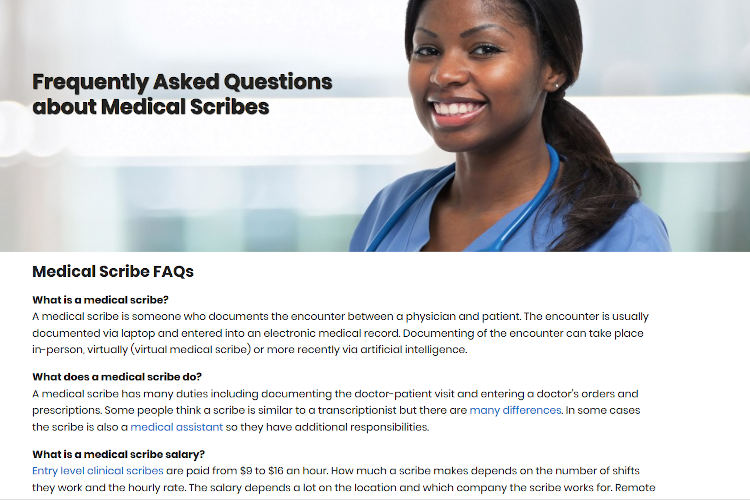
Frequently Asked Questions about Medical Scribes
Medical Scribe FAQs
A medical scribe is someone who documents the encounter between a physician and patient. The encounter is usually documented via laptop and entered into an electronic medical record. Documenting of the encounter can take place in-person, virtually (virtual medical scribe) or more recently via artificial intelligence.
A medical scribe has many duties including documenting the doctor-patient visit and entering a doctor’s orders and prescriptions. Some people think a scribe is similar to a transcriptionist but there are many differences. In some cases the scribe is also a medical assistant so they have additional responsibilities.
Entry level clinical scribes are paid from $9 to $16 an hour. How much a scribe makes depends on the number of shifts they work and the hourly rate. The salary depends a lot on the location and which company the scribe works for. Remote scribes or telescribes are sometimes on different pay scales than in-person scribes.
Medical scribes remove the burden of completing the electronic medical record so the doctor can spend more time with patients and focus on good care. Other benefits include more job satisfaction, better documentation, more revenue, and greater efficiency.
There are many paths to becoming a scribe, you can apply online to job listings posted by clinics or scribe companies. Scribe companies have good training programs and will take people without any experience or certification. Medical centers and local community colleges also offer clinical scribe programs. Showing a base level of medical scribe knowledge can help you land that first interview and get the job. In some cases, doctors hiring one or two scribes for their office will require previous experience or certification showing a base level of proficiency.
Pre med students or pre nursing students most often apply for positions. College juniors, seniors and recent graduates, as well as individuals who have completed a two-year associates degree often meet qualification criteria. These people are motivated and eager to get clinical experience.
Most patients are OK with the scribe taking notes electronically. Scribes are viewed as part of the medical team. Patients appreciate that the scribe allows the doctor to focus on the patient instead of looking down and feverishly typing on a laptop computer.
Scribes usually work 8 to 12 hour shifts and this depends on the needs of the doctors. There is often flexibility in scheduling so students can work one or two shifts per week. Most scribe companies want a two year commitment but often will settle for one year.
Emergency medicine, internal medicine, pediatrics and family practice are common specialties employing medical scribes. However, scribes are used in just about every specialty including optometry, podiatry, oncology and neurology.
There are many factors which influence the time needed to start a scribe program at a hospital, clinic, ER department or doctor’s office. One of the biggest factors is whether you will hire scribes yourself or contract with an outside scribe company.
Recruiting and training are other items to consider. Creating online job postings and conducting interviews take time. Training scribes yourself may take longer and require more effort compared using 3rd-party scribes.
